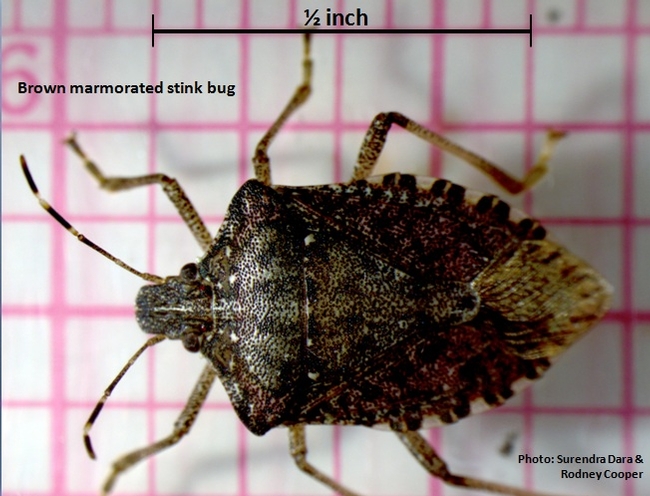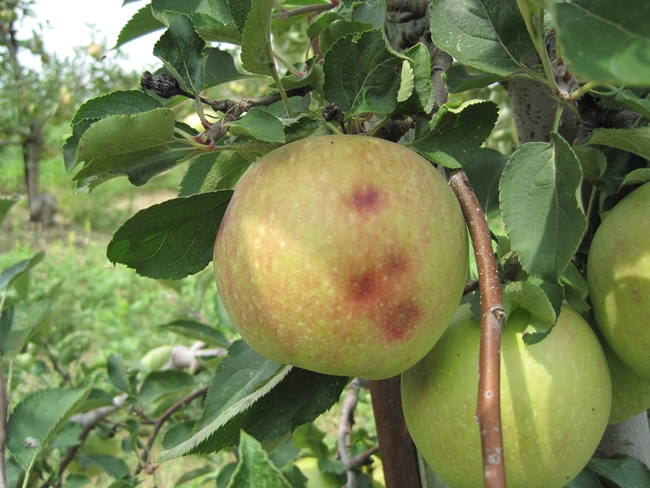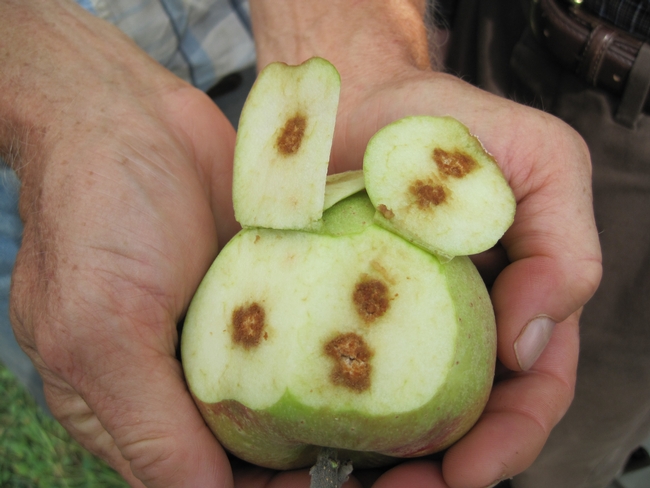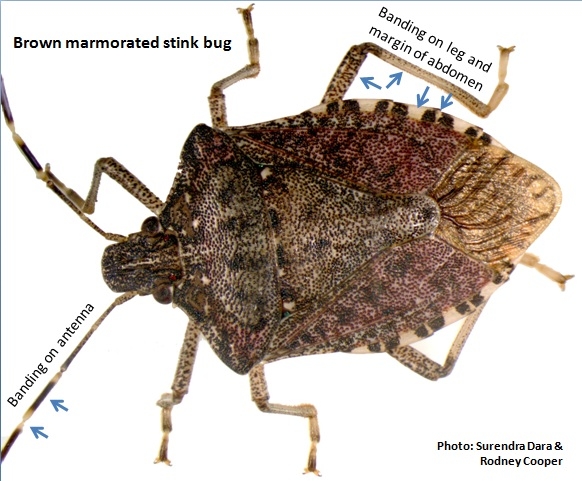
Brown marmorated stink bug adult male (Photo by: Surendra Dara, UCCE and Rodney Cooper, USDA-ARS)
Brown marmorated stink bug (BMSB), Halyomorpha halys Stål was recently found in San Luis Obispo County in an incoming shipment of household items from Pennsylvania, where it is considered as a serious pest. Ag Commissioner's office took immediate action to eradicate this intruder by physical removal and chemical treatments. In light of this, here is a brief note on this invasive pest.
Origin and distribution:BMSB is native to Asia and is considered as an important pest in China, Japan, Korea, and Taiwan. It was first reported in Pennsylvania in late 90s and is now reported in a majority of the states in the US. However, reproducing populations may not be present in all the states it was found. In California, Los Angeles County is the only place where populations of BMSB are known to exist.
Host range: It has a wide host range that includes about 300 species according to a report. It feeds on a variety of hosts that include fruit trees, broadleaved trees, vegetables, field crops, and ornamental plants. It is also a nuisance to homeowners as it looks for hiding locations in or around the houses to overwinter.

Depressions on the fruit surface normally result from late season feeding damage of BMSB (above). Corking injury due to the necrosis of damaged tissue (below). (Photos by Chris Bergh, Virginia Tech)

Damage: BMSB has piercing and sucking mouthparts with which it sucks plant juices from fruits, pods, or other parts and causes malformation, discoloration or cloudy spots, depressed areas, and wart-like growth depending on the plant or damaged part. Small dark spots also develop as a result of puncturing by its mouthparts and these areas can harbor secondary infections. BMSB is also known to transmit witches' broom, a phytoplasma disease in princess tree (Paulownia tomentosa) in Japan, but such disease transmission has not been reported in the US.

Characteristic features that help distinguish the brown marmorated stink bug from other stink bugs
(Photo by: Surendra Dara, UCCE and Rodney Cooper, USDA-ARS)
Biology: BMSB belongs to the stink bug family Pentatomidae in the order Hemiptera. It is a shield shaped bug which emits pungent odor when disturbed. Adults are 12-17 mm long with mottled brown body. Last two antennal segments have alternating light and dark bands which appear as a single white band. This is a characteristic feature of this species. Exposed margins of the abdomen (not covered by the wings) have alternating brown and white bands. White bands are also seen on legs. Eggs are spherical to barrel-shaped, white to pale green and deposited each week in clusters of 20-30 on the underside of leaves. Female can lay 250-400 in its life time. There are 5 nymphal instars which range in size from 2.4 to 12 mm. First instar nymphs are reddish orange and second instars are black. Later instars develop brown coloration. Depending on temperature, egg stage lasts for 4-5 days and each nymphal instar for a week. Adults reach sexual maturity in two weeks.
Adults mate in spring and females continue egg laying for the next few months. Adults gather in large numbers in fall in search of overwintering places. In warmer regions of China, BMSB has multiple generations per year. In the US, it was initially thought to have a single generation, but recent reports indicate more than one generation per year.
Management: Hand removal or vacuuming is the best way to remove BMSB in or around homes. Mechanical exclusion by sealing the cracks and crevices that serve as hiding locations, and using screens for doors and windows is also important. Various insecticides are available for managing this insect in other situations. In laboratory bioassays, pyrethroid insecticides (especially bifenthrin) were more effective compared to neonicotinoids and an organophosphate compound. Males were less susceptible than the females to thiomethoxam (neonicotinoid). There are no known natural enemies in the US, but an egg parasitoid [Trissolcus halymorphae Yang (Hymenoptera: Scelionidae)] is found to be very effective in China.
What to do: It is important to note that care must be taken to exclude pests in packages while moving from other areas. If you notice BMSB in your surroundings, bring it to the attention of the Ag Commissioner or contact me at skdara@ucdavis.edu or 805-781-5940.
http://ucanr.edu/articlefeedback
References:
Bernon, G. K., M. Bernhard, E. R. Hoebeke, M. E. Carter and L. Beanland. 2004. Halyomorpha halys, (Heteroptera: Pentatomidae), the brown marmorated stink bug; Are trees the primary host for this new invasive pest? GTR-NE-332. Proc. XV USDA Interagency Res. Forum on Gypsy Moth and Other Invasive Species 2004
Jones, J. R. and P. L. Lambdin. 2009. New county and state Records for Tennessee of an exotic pest, Halyomorpha halys (Hemiptera: Pentatomidae), with potential economic and ecological implications. Florida Entomologist 92: 177-178.
Nielsen A. L, P. W. Shearer, G. C. Hamilton. 2008. Toxicity of insecticides to Halyomorpha halys (Hemiptera: Pentatomidae) using glass-vial bioassays. J. Economic Entomol. 101: 1439-1442.
Yang Z., Y. Yao, L. Oiu , Z. Li. 2009. A new species of Trissoltus (Hymenoptera: Scelionidae) parasitizing eggs of Halyomorpha halys (Heteroptera: Pentatomidae) in China with comments on its biology. Annals of the Entomological Society of America 102: 39-47.
Additional resources:
http://edis.ifas.ufl.edu/in623
http://ento.psu.edu/extension/factsheets/brown-marmorated-stink-bug
http://entnemdept.ufl.edu/creatures/veg/bean/brown_marmorated_stink_bug.htm
http://pestthreats.umd.edu/content/documents/BMSBFactSheet_10-2010_000.pdf
http://www.aphis.usda.gov/plant_health/plant_pest_info/bmsb/index.shtml
http://www.entsoc.org/PDF/Pubs/Periodicals/AE/AE-2009/Spring/Hamilton-sym.pdf
